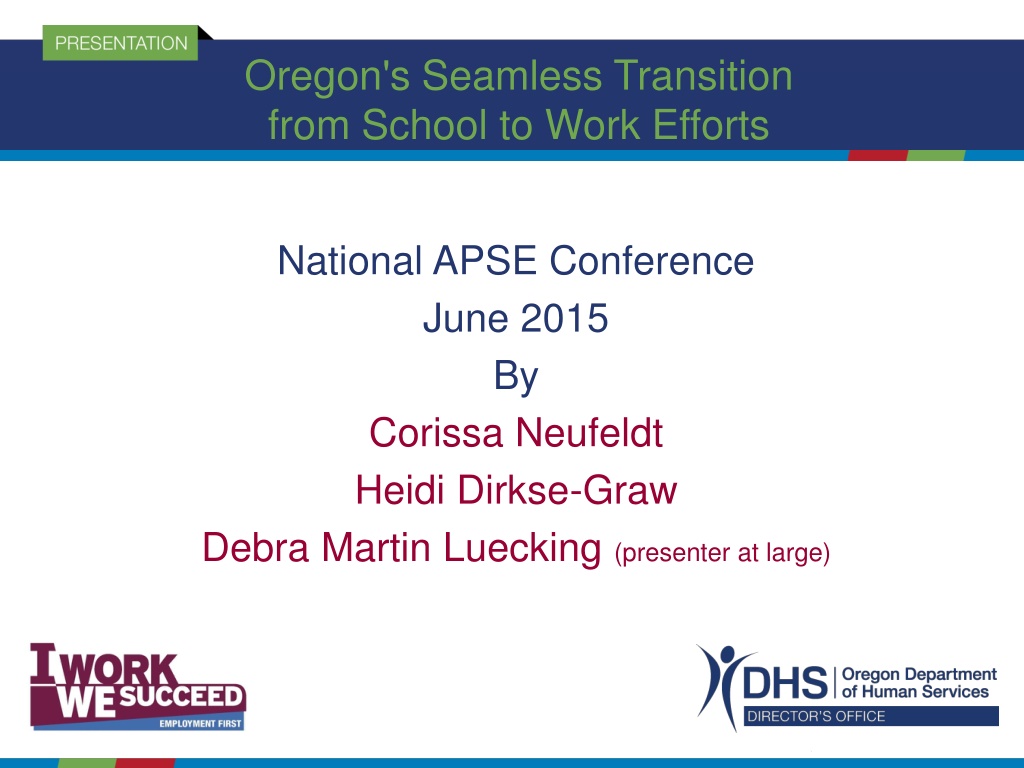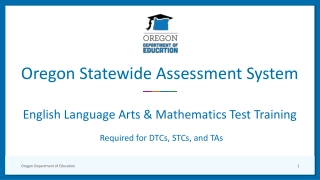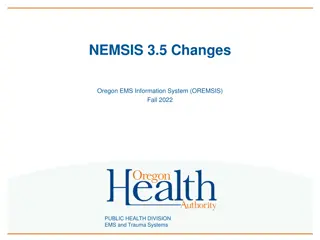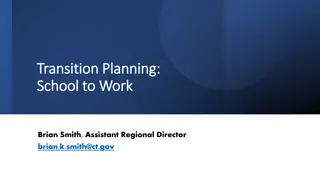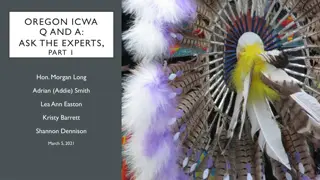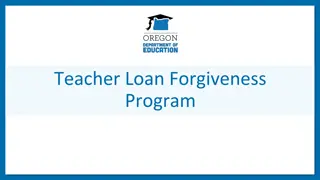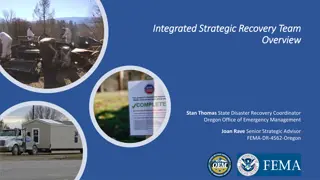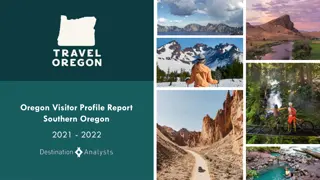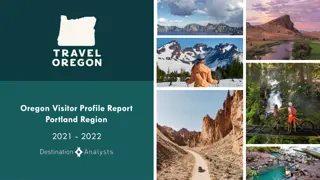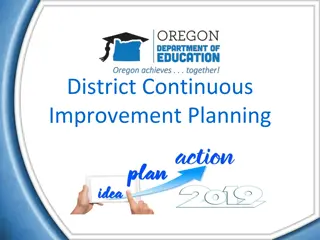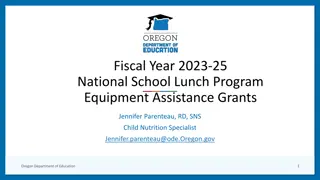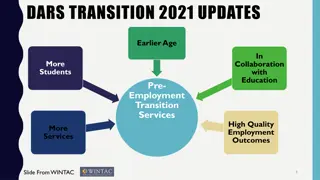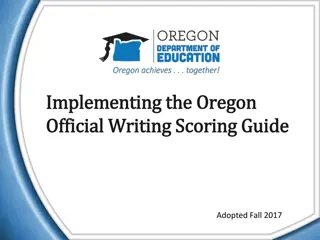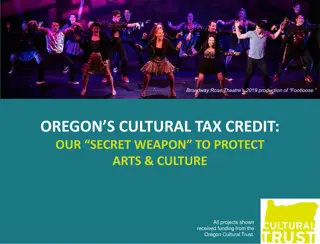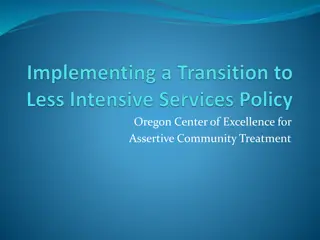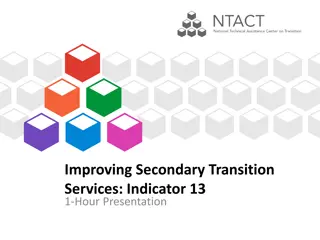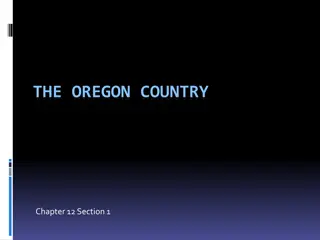Oregon's Seamless Transition from School to Work
Oregon has been implementing a Seamless Transition program to facilitate the smooth shift from school to work for individuals with disabilities. The initiative focuses on creating a collaborative and uninterrupted pathway from secondary education to employment or postsecondary education. The program addresses barriers such as coordination gaps in services, limited work experiences, and insufficient post-school support. With a belief that there is a job for everyone who desires one, regardless of disability, the initiative aims to promote inclusive employment opportunities for all. Key aspects covered include the initiative's background, model identification, operationalization, challenges, successes, data outcomes, and sustainability measures.
Download Presentation

Please find below an Image/Link to download the presentation.
The content on the website is provided AS IS for your information and personal use only. It may not be sold, licensed, or shared on other websites without obtaining consent from the author.If you encounter any issues during the download, it is possible that the publisher has removed the file from their server.
You are allowed to download the files provided on this website for personal or commercial use, subject to the condition that they are used lawfully. All files are the property of their respective owners.
The content on the website is provided AS IS for your information and personal use only. It may not be sold, licensed, or shared on other websites without obtaining consent from the author.
E N D
Presentation Transcript
Oregon's Seamless Transition from School to Work Efforts National APSE Conference June 2015 By Corissa Neufeldt Heidi Dirkse-Graw Debra Martin Luecking (presenter at large)
Agenda Background Overview of Seamless Transition and the Model Identification and Organization of Pilot Sites Operationalizing the Pilot SME s and Training/Technical Assistance Pilot Challenges, Successes and Ah-Ha s Data Outcomes Local Sustainability and Going to Scale State Sustainability and going to Scale Closing
Background Oregon s Employment First Initiative Employment First Policy 2008 Senate Bill 22 Legislation-2013 Executive Order 13-04 April 2013 Executive Order 15-01- February 2015
What is Seamless Transition? For the exiting student: The Next Day After High School is the Same as the Day Before Luecking, D.M. & Luecking, R., 2015m Translating Research into a Seamless Transition Model, Career Development and Transition for Exceptional Individuals
Seamless Transition A sequential delivery of specific transition service features beginning in early high school and . the braiding of resources of transition partners Resulting in uninterrupted, collaborative transition from public secondary education to employment and/or postsecondary education. Luecking, D.M. & Luecking, R., 2015m Translating Research into a Seamless Transition Model, Career Development and Transition for Exceptional Individuals
Known Barriers for Seamless Transition Gaps and lack of coordination in school-based services Limited access to work experiences and employment services Insufficient post- school support services Lack of connection with adult services Luecking, D.M. & Luecking, R., 2015, Translating Research into a Seamless Transition Model, Career Development and Transition for Exceptional Individuals.
What we believe There s a job for everyone who wants one, regardless of disability, need for support, or economic vitality of their community Work is Good! Luecking, D.M. & Luecking, R., 2015, Translating Research into a Seamless Transition Model, Career Development and Transition for Exceptional Individuals.
Beliefs Job seekers need to be actively involved in decisions made about their future and empowered to make these decisions Effective job development is highly individualized Luecking, D.M. & Luecking, R., 2015, Translating Research into a Seamless Transition Model, Career Development and Transition for Exceptional Individuals.
Beliefs The aspirations, skills, and positive attributes of a job seeker must match the needs, expectations, and workplace culture of the employer No one agency can do it alone linkage with school and other key partners is critical Luecking, D.M. & Luecking, R., 2015, Translating Research into a Seamless Transition Model, Career Development and Transition for Exceptional Individuals.
Expected Key Outcomes At the Point of Transition Schools teaming with VR, community provider Families engaged in transition process Early VR involvement Early Community Provider involvement Positive personal career planning Individualized paid work experiences Individualized paid inclusive job Supports in place prior to exit Luecking, D.M. & Luecking, R., 2015, Translating Research into a Seamless Transition Model, Career Development and Transition for Exceptional Individuals.
Expected Key Outcomes Longer Term Collaborative teaming across key partners Systematic delivery of model sustained Braiding of funding and resources Maintaining individualized competitive integrated job Successful VR case closure Ongoing support needs maintained Career advancement services available Luecking, D.M. & Luecking, R., 2015, Translating Research into a Seamless Transition Model, Career Development and Transition for Exceptional Individuals.
Research Based Seamless Transition Model Based on Guideposts for Success (NCWD/Y, 2005) Youth empowerment & self-determination Work experiences & job development Family supports Connecting activities & systems linkages Social & health services Luecking, D.M. & Luecking, R., 2015, Translating Research into a Seamless Transition Model, Career Development and Transition for Exceptional Individuals.
Features of Seamless Transition Model Community-based integrated work experiences relevant to attaining adult employment Employment in integrated settings where they are hired by the employer Non-work activities in community settings Adult provider working with school personnel before school exit Cost sharing resources- LEA,VR, DD,MH Outcome of paid work with supports in place before school exit Luecking, D.M. & Luecking, R., 2015, Translating Research into a Seamless Transition Model, Career Development and Transition for Exceptional Individuals.
Seamless Transition Flow of Student Services 10th Grade (or 3 yrs prior to exit) 11th Grade (or 2 yrs prior to exit) 12th Grade (or 1 yr prior to exit) Post School Completion (2 yrs beyond high school) VR In Competitive Integrated Employment (CIE) Service Outcomes opens case Post school Follow Up ENROLL Applications for Post school (DD,MH) DISCOVERY PROCESS In CIE employment receiving supports from CRP (if needed) Selection Criteria Desire to participate Need supports to seamlessly transition Receiving Special Education services Eligible for VR service Self-determination instruction Positive personal/ career profile Work-based Experiences Paid Employment Supports Direct Services or Student-led IEP development Health & Social Linkages Enrolled postsecondary education receiving supports from Disability campus services (as needed/as requested) Family Support/Participation Public Benefits Management (all services are adjunct to school and academic preparation) Luecking, D.M. & Luecking, R., 2015, Translating Research into a Seamless Transition Model, Career Development and Transition for Exceptional Individuals.
Flow of Student Services 10th Grade (or 3 yrs prior to exit) ENROLL Service Outcomes DISCOVERY PROCESS Selection Criteria Desire to participate Need supports to seamlessly transition Receiving Special Education services Eligible VR service Self-determination self-advocacy instruction Positive personal / career profile Student-led IEP development Direct Services Family Support/Participation (all services are adjunct to school and academic preparation) Luecking, D.M. & Luecking, R., 2015, Translating Research into a Seamless Transition Model, Career Development and Transition for Exceptional Individuals.
Flow of Student Services 11th Grade (or 2 yrs prior to exit) VR opens case Applications for Post school Service Outcomes VR Work-based Experiences Direct Services Student-led IEP development Family Support/Participation (all services are adjunct to school and academic preparation) Luecking, D.M. & Luecking, R., 2015, Translating Research into a Seamless Transition Model, Career Development and Transition for Exceptional Individuals.
Flow of Student Services 12th Grade (or 1 yr prior to exit) In CIE Service Outcomes Paid Employment Supports Direct Services Health & Social Linkages Public Benefits Management (all services are adjunct to school and academic preparation) Luecking, D.M. & Luecking, R., 2015, Translating Research into a Seamless Transition Model, Career Development and Transition for Exceptional Individuals.
Flow of Student Services Post School Completion (2 yrs beyond high school) Post school Follow Up Service Outcomes In CIE receiving supports from CRP (if needed) Direct Services Luecking, D.M. & Luecking, R., 2015, Translating Research into a Seamless Transition Model, Career Development and Transition for Exceptional Individuals.
KEY Linkage for operational or direct services Potential resources for Job Seeker Job Seeker Employer D E M A N D Community Rehabilitation Providers LEA Additional Resources Independent Living Center Local Project Management Team Social Security Assistive Technology Center Mental Health Post Sec Developmental Disabilities Education Vocational Rehabilitation One-Stop Career Center S U P P L Y Luecking, D.M. & Luecking, R., 2015, Translating Research into a Seamless Transition Model, Career Development and Transition for Exceptional Individuals.
Oregon Innovation Project Core Teams a subset of Local Employment First Teams Identify seamless transition policy and processes, and Identify effective local collaboration strategies
Funding Support US DOL, Office of Disability Employment Policy (ODEP) 2012 Grant Oregon Department of Human Services (DHS) Local In-kind support from participating agencies
Employment First Seamless Transition Pilot Teams Sites Multnomah Umatilla Washington Clackamas
Key Informing Groups Students & Families 5 school Districts Vocational Rehabilitation System Agency Staff (DD,MH,SSA) Employment Providers Local Partners (Advocacy, CILs, Parent Networks)
Participating Students Year 1 Students Year Exiting 7 2014 23 2015 10 2016 5 2017 Luecking, D.M, (2014). Oregon Employment First Seamless Transition Project Year 1 Student Outcomes Report October 1, 2013 September 30, 2014.
Participating Students Year 2 Students Year Exiting 21 (3 drop outs) 2015 12 2016 9 (so far) 2017 Data from Clackamas, Multnomah, Umatilla and Washington Co. Pilot Site Quarterly Reports January 1, 2015- March 31, 2015.
Leadership Support US DOL, ODEP Employment First Seamless Transition Pilot (EFSTP) Project Manager Subject Matter Experts (SME s) State and Local Leadership (VR, DD, ED, Parent Network )
Operationalizing the Pilot Monthly Team Meetings Quarterly Community of Practice Meetings Administrative Responsibilities >Quarterly reports >Monthly Call-ins for Leadership >Fidelity Scale >Implementation Plan
Subject Matter Experts (SME) SME s provide Training & Technical Assistance > Debra Martin Luecking, Marsha Threlkeld, & Ray Jensen Each EFSTP team has SME support: > Objectives and expectations of pilot > Guidance on best practices > Strategize state & local interagency policy and practice alignment (fidelity checklist & Implementation plan) > Understand and implement T & TA > Strategize local capacity building
Trainings Discovery Customized Employment Family Engagement Behavioral Supports & Assistive Technology to support students with the most significant challenges to obtain CIE
Pilot Challenges Funding Service definitions Low expectations of families Fear of losing benefits Transportation limitations of students Cross agency collaboration
Pilot Successes Development of team collaboration through shared vision, mission and plan Braiding of interagency resources Unifying and Standardization of service provision Getting students placed into jobs
Pilot Ah-Has Parental support impacts employment outcomes Sharing success stories creates positive expectations for students Formal Discovery by a trained employment specialist can fast track job placement
Outcomes So Far Clarifying local Roles and Responsibilities Discovery through Collaboration Customized Employment Skills Summer Youth Work Experience and Protocol Alignment Recommendations to State Policy Makers funding & protocol 2014 Students Left School with Jobs 2015, 2016 and 2017 Students in Summer Youth Work Experiences
Data Site Discovery Linked VR Linked DD Linked Provider In Paid Work Experience In Inclusive job* *In follow up (post- graduation 12 15 10 14 3 6/100% 6 Clackamas 20 Students 8 11 6 11 7 3/33% (1 in job at exit; 2 in job dev. Process) 2 (got jobs) 1 w/job in follow up. 3/100% Multnomah 12 Students 7 1 (7 in process) 2 (4 in process) 1 0 2/100% 2 Umatilla 8 Students 10 14 13 11 2 2/100% 2 Washington 17 Students 37/65% 48/84% 35/61% 37/65% 12/21% 13 13 Total Students: 57 Source: EFSTP January-March 2015 Site Progress Quarterly Report Cumulative Student Data compiled by Debra Martin Luecking, EdD.
Local Sustainability Reference and update the Seamless Transition Site Implementation Plan regularly Identify roles and responsibilities Create a yearly calendar of activities for the team Continue monthly EF Seamless Transition Team meetings > Track and plan student progress > Problem solve issues and barriers > Celebrate success
State Sustainability Expanding to other Counties Capacity building, including engaging Work Force entities more Importance of local leadership support Maintaining Fidelity to the Seamless Transition Model: > parent/family engagement > Local interagency collaboration > Local MOU s Standardizing policies, procedures & tools (who, when, how, funding): > Discovery > Work Experiences, including Summer Youth Work Experiences > Linkages to adult services
Conclusion Add Video
Contact Information Corissa Neufeldt Policy & Innovation Coordinator Department of Human Services Employment First Initiative 503-945-6745 office Corissa.Neufeldt@state.or.us Heidi Dirkse-Graw, M.S. CRC President/CEO/Counselor DIRKSE Counseling & Consulting, Inc. 503-516-8073 Office http://www.dirksecc.com Debra Martin Luecking, EdD President, LueMar Consulting Group 301.803.0859 Cell 304.258.1569 Office dluecking@luemarconsulting.com
